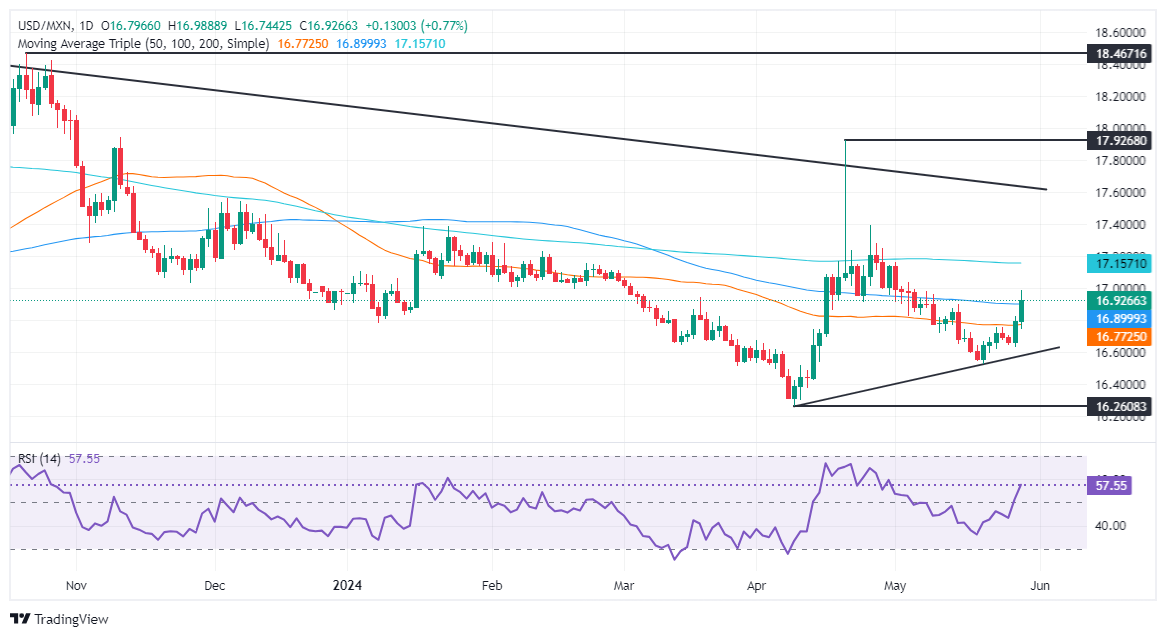For the latest news on the Mexican Peso click here.
- Mexican Peso plummets sharply, posting losses of almost 1%.
- Investors reduce Peso exposure ahead of June 2 general election, favoring the Greenback.
- Upcoming PCE data and Mexico’s election results to dictate USD/MXN trajectory.
The Mexican Peso depreciated sharply against the US Dollar on Wednesday as US Treasury bond yields underpinned the Greenback. The Bank of Mexico revealed its Quarterly Report, in which Banxico updated its forecasts. The USD/MXN trades at 16.96 and gains more than 1%.
The Mexican currency is pressured due to a risk-off environment. Meanwhile, traders seem to be trimming their exposure to the Mexican Peso as Sunday, June 2, general election loom.
Most polls see Claudia Sheinbaum of Morena’s ruling party winning the presidential election. But most analysts estimate that either way, Sheinbaum’s win or Xochitl Galvez's surprise upset, both candidates are seen as market friendly.
In addition, Banxico updated its forecasts for inflation, core prices, and growth. Headline inflation is expected to finish at 4%, up from 3.5%, while underlying inflation is expected to increase from 3.5% to 3.8%. Mexico’s economy is expected to grow just 2.4% in 2024, down from 2.8%.
Banxico acknowledges that despite the inflationary outlook continuing to be complex and challenging, it expects a resumption of the disinflationary process.
Across the border, US Treasury bond yields along the whole curve continued to climb for the second straight day amid a scarce economic docket. Regional Manufacturing Indices revealed by the Richmond and Dallas Fed were mixed, while investors waited for New York Fed President John Williams's speech.
On Tuesday, Minneapolis Fed President Neel Kashkari was hawkish. He said that Fed officials hadn’t disregarded rate hikes, while adding that if they cut borrowing costs, it would be twice toward the end of 2024.
Meanwhile, traders brace for the release of April’s Personal Consumption Expenditures Price Index (PCE), the Federal Reserve’s (Fed) preferred inflation gauge. That, along with Mexico’s general election on Sunday, could dictate the USD/MXN path toward the second half of the year as the Mexican currency remains one of the strongest against the US Dollar.
Daily digest market movers: Mexican Peso drops on high US yields, Fed comments
- Last week’s data showed that Mexico’s economic outlook is turning uncertain as the mid-month headline inflation for May rose while underlying prices dipped.
- Mexico’s economic slowdown, as shown by the last Gross Domestic Product (GDP) report and a widening trade deficit, could exert pressure on Mexican Peso.
- May’s Citibanamex poll showed that most economists estimate Banxico will cut rates on June 27 from 11% to 10.75%. The median expects headline inflation at 4.21% and core at 4.07% in 2024.
- Mexico’s schedule will feature the Unemployment Rate, the Fiscal Balance, Foreign Exchange Reserves, and the general election on June 2.
- The Richmond Fed Manufacturing Index rose by 13 in May, exceeding April’s -10 contraction. The Services Index for the same period improved from -13 to 3.
- May’s Dallas Fed Services Index plunged from -12.1 to -10.6.
- In the week ahead, the US economic docket will feature the second estimate of Gross Domestic Product (GDP) for Q1 2024, unemployment claims for the last week, and the release of core PCE.
- Despite that, fed funds rate futures estimate just 24 basis points of easing toward the end of the year.
Technical analysis: Mexican Peso falls as USD/MXN climbs above 16.90
The USD/MXN downtrend remains intact, yet buyers are gathering steam as the pair tests the 100-day Simple Moving Average (SMA) at 16.76. Momentum shows that bulls are gaining traction as the Relative Strength Index (RSI) is about to pierce above the 50-midline to turn bullish.I
Buyers decisively surpassing the 100-day SMA at 16.70 could open the door for further gains. The next resistance would be the 50-day SMA at 16.89, the psychological figure at 17.00, and the 200-day SMA at 17.14.
On the other hand, a bearish continuation would happen if sellers keep the exchange rate below the 100-day SMA, which could pave the way for a dip to the 2023 low of 16.62, followed by the May 21 cycle low at 16.52 and the year-to-date low of 16.25.














